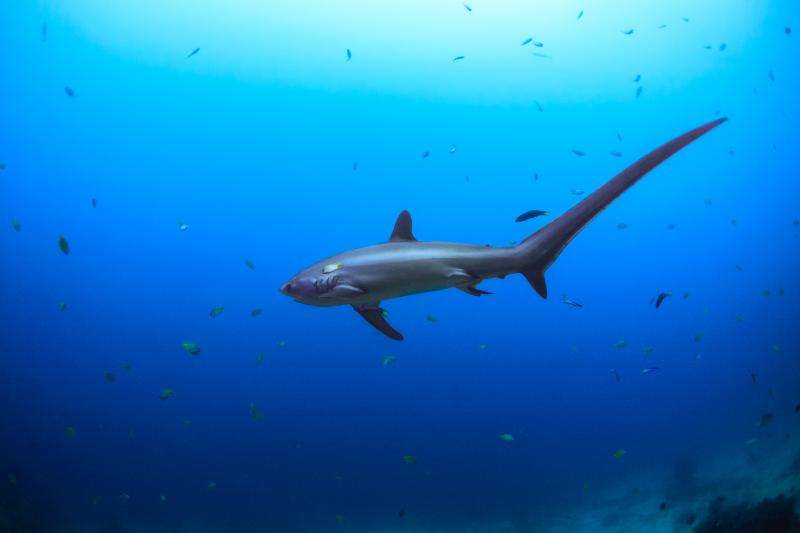Tracking a rarely seen, endangered 'ninja' shark in the philippines

Rutgers marine scientist Thomas Grothues is well known for his expertise in tracking fish. He was recruited last year by a colleague from England to track a rarely seen shark species in the Philippines.
The underwater adventure – in which Grothues played a prominent role – was featured recently in the documentary Ninja Sharks, which aired as part of the Discovery Channel's annual Shark Week.
Grothues, an associate research professor in the School of Environmental and Biological Sciences, spent a month with Simon Oliver, a scientist from the University of Chester in England, and others tracking pelagic thresher sharks – which are found in the tropical and subtropical waters of the Indian and Pacific Oceans.
There is a lot that scientists need to learn about this shark whose beauty, grace and reclusiveness are an important draw for tourists in the Philippines. "Their presence adds to this world," said Grothues. "But without further knowledge of their distribution, numbers and feeding habits, it is hard to predict how, when and how much they impact human economies and the environment."
People living on Malapasqua Island in the Philippines have built a tourist trade around thresher sharks, which come to a local reef to have parasites cleaned off their bodies by tiny fish called wrasse. Threshers, known for their athleticism, use their sword-like tails as a 50-mph whip to stun small fish like sardines and mackerel, which ultimately become their prey. The sharks pose little threat to humans – the greatest risk is to divers who may be hit by their enormous tails.
The biggest threat to these sharks, Grothues says, is overfishing. While some fishermen catch them for sport, other fishermen are after their fins, liver oil, tails and flesh.
New Jersey also has thresher sharks (of two different species) one of which (the common thresher) often enters shallow coastal waters. The other species, the bigeye thresher stays off-shore in relatively deep waters.
The Discovery documentary, which aired in July, focused on sharks that have developed adaptations to help them become effective predators. Besides the thresher shark, Discovery sponsored research on five other shark species: whitetips, makos, salmon sharks, hammerheads and bull sharks.
Grothues spent a month with Oliver and other scientists aboard the motor yacht Vasco, tracking thresher sharks tagged by other members of the team.
"Simon had read some of my papers on AUV (autonomous underwater vehicle) tracking, and he was thinking about having an AUV track sharks off the reef at Malapasqua, so you could see them on sonar," Grothues said. "I told him it would be better in this situation to do it the old-fashioned way – tag the shark with a transmitter and follow it. That's when he said, 'Well, that's why I wanted to talk to you. Do you want to come do this?'"
Oliver and Grothues wanted to find out how many sharks regularly came to the reef for cleaning, how far they go, in which direction, how deep they dive between visits and how vulnerable they are to overfishing. First came the tagging with a transmitter, followed by the placement of receivers that allow Grothues to track the sharks return and mobile detectors to follow them one at a time. "We saw that some sharks came back (to the reef) every day; some every second or third day," Grothues said. "They tended to follow a path, a shark highway, when they left the reef. We would pick a shark in the morning and follow it off the reef, and then for hours be tracking two or three together."
When the sharks left the tourist island of Malapasqua, most headed north toward Leyte, a fishing and farming island rather than south, toward Cebu known more for tourism. Their path put them in greater danger of being caught by an illegal fishery.
''This makes them more vulnerable,'' Grothues said. "We are much more interested in returning to understand the sharks' use of other environments, particularly their connection to open sea populations. We don't know if these sharks are migrants or locals in the long-term sense. Clearly they know this reef and the cleaners are here, but how far are they willing to travel for that service?"
Provided by Rutgers University
















